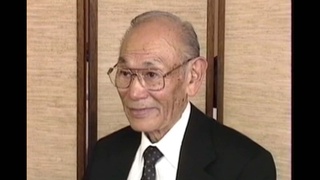Interviews
Miscommunications
I asked if she would meet me in Kamakura again, to see the Daibutsu I guess, that's how it happened. And so I...the next couple—it was a week later anyway—we were to meet again in Kamakura. I came all the way from Kamakura and I went to the meeting place and no Hamako—she didn't show up. So I got real mad to be stand—stood off by a Japanese girl and so it happened that she couldn't help it, she wrote a letter to me and...at this building where I was located in Japan, I mean in Tokyo...oh gosh I wish I could remember it. But anyway, the letter was intercepted by the army and the letter said, something...I couldn't make it this week that we had the date and...but I didn't know because the army would not allow any correspondence between officers and enemy people—which the Japanese were at that time—considered.
And so, let's see I don't know how she came and apologized, she showed me the letter that was sent back to her—the army intercepted it and sent back to her—so she showed me the letter and so I couldn't get mad then so from then on we dated.
Date: January 26, 2012
Location: California, US
Interviewer: John Esaki, Yoko Nishimura
Contributed by: Watase Media Arts Center, Japanese American National Museum







